Resource Planning for Multiple Projects: Top 10 Strategies
Resource planning for multiple projects is a huge challenge in itself, even if you’re an expert project manager.
Here, we’ve compiled the top 10 strategies for planning resources when managing multiple projects in 2025. We’ll also teach you how to use the right tools and share tips for solving common industry challenges that come with management of multiple projects.
Free Capacity Planning Template
Download our template to schedule time for billable vs non-billable tasks, track workloads, and get insights into utilization with preset formulas.

What Are the Best Strategies for Resource Planning Across Projects?
Planning resources for multiple projects starts with prioritizing your most valuable projects—trying to give equal attention to everything spreads your team too thin. Set clear expectations during project planning and define responsibilities early to avoid overcommitment.
Communicate openly with stakeholders to stay aligned on goals, timelines, and potential roadblocks. Track your team’s utilization rate to catch signs of burnout or inefficiency.
You should also use standardized processes, forecast future needs of company enterprise resources, and automate repetitive tasks wherever possible.
Below, we’ll break down each resource planning strategy, then move on to the challenges and benefits.
1. First prioritize projects then plan individual resource needs
Consider the Pareto Principle, which suggests that 80% of goals arise from 20% of efforts. Applied to the topic of client prioritization, it would signify that a smaller amount of clients are actually bringing significant profits to your company.
However, this is something you must be able to control in a multi-project environment. Trying to put the same amount of effort into all of your projects can end up stretching your resources too thin and causing burnout.
Additionally, you will likely produce low-quality results across the board, rather than delivering a mix of outstanding and acceptable work. This is why it’s essential to determine your project priority ahead of time so that you know exactly what to do once resource conflicts arise.
Sometimes, the pitfall is in deciding which projects you should prioritize. To solve this problem, you should use software that can give you a comparison of how different projects are performing profitability-wise. This can be a great first step to determining basic project value.
Then, consider qualitative factors. Prioritizing based on profitability involves not just looking at the immediate financial gains but also considering the long-term strategic value, such as fostering relationships with key clients or venturing into new markets.
2. Maintain realistic expectations during project planning
According to the 2015 Chaos Report, under 50% of projects are completed on time and on budget, with a little over 50% being completed on target, or with all promised functionalities.
When it comes to improving your project delivery game you should do the follwing:
- Unify workstreams and eliminating silos (learn more on our dedicated guide on workstream management)
- Automate repetitive tasks (more on that later)
- Utilize real-time overviews
- Work on the basis of accurate data
Now, let’s consider the project initiation and planning process. Are you establishing realistic expectations and defining everything that needs to be done in your client contract clearly enough?
Take website project management: one of the main things that are often overlooked in client contracts is just how extensive the maintenance period of development should be. This also includes the scope of changes that are expected to be applied: does this include bug fixes or additional feature requests?
It’s important to put all of these terms into place in order to prevent the overcommitment of resources, as well as client dissatisfaction.
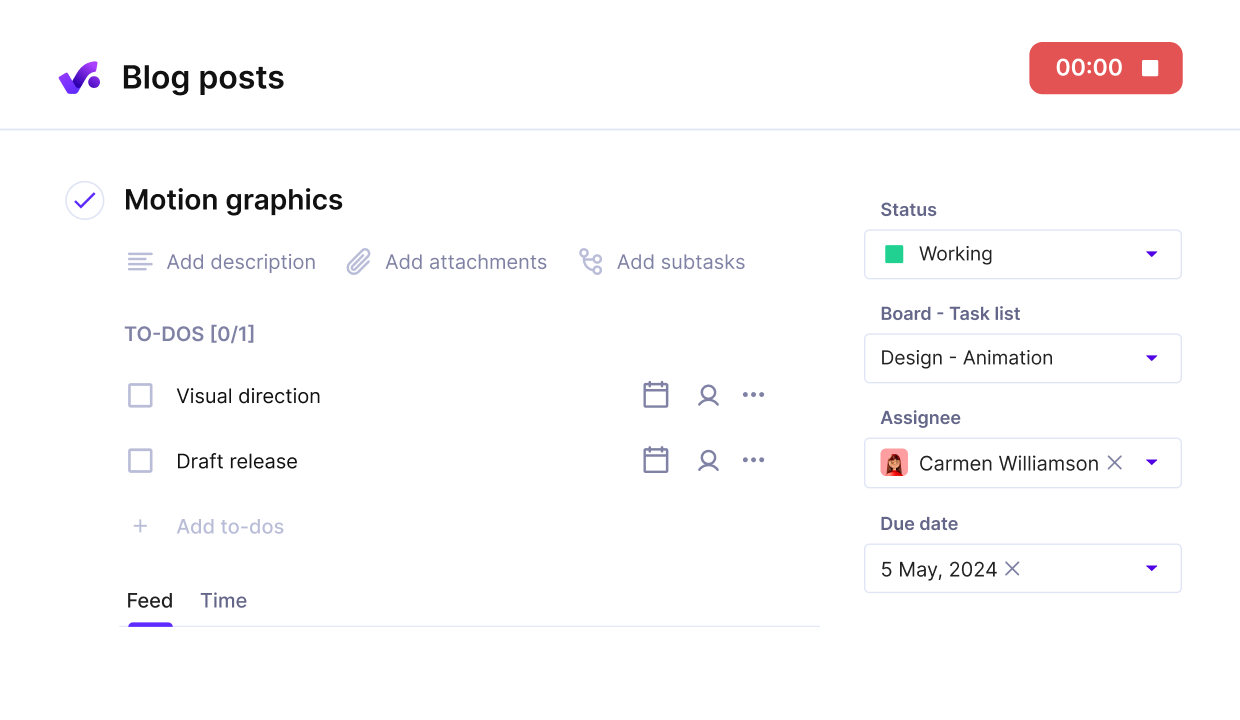
GET SIMPLIFIED COMMUNICATION BETWEEN PROJECT TEAM MEMBERS.
3. Maintain clear and transparent communication
Moving past the contract stage, maintaining transparent communication with project stakeholders throughout the process is equally important.
This involves regularly updating them about the project’s progress, potential roadblocks, and any changes in resource allocation or timelines. A simple way to improve your client communications would be by using project management software for agencies.
I think that in project management there’s a tendency to focus solely on profitability, but it’s inevitable that projects will go over budget, and that’s ok. However, it’s important to have transparency on where that stands, and Productive gives us that visibility.
For example, with Productive you can invite clients to your projects free of charge. Your clients can directly view the progress made on tasks, as well as leave comments on particular deliverables. This can significantly speed up the feedback process, as everyone involved can immediately view what needs to be done, without the need for a manager to play middle man.
Additionally, you can open advanced permission so that clients can view basic information on budgets and time sheets, including prices, time worked, and estimated time on tasks.
All of this can help you enhance stakeholder trust and improve the chances of delivering your project within the set scope, project schedule, and budget.
4. Manage your resource utilization rate
People are the most valuable resources. Resource scheduling in project management is often about scheduling people. One of the best ways to measure the success of your resource planning across multiple projects is your utilization rate (especially when handling multiple projects).
The resource utilization formula is calculated as the percentage of billable hours vs non-billable hours worked. It can show you which one of the multiple projects needs improvement, and which ones are performing optimally.
Another important thing that the utilization rate indicates is whether you’re burdening your resources (staff) too much. Don’t fall into the trap of aiming for perfect utilization (have your staff work until they burn out)— though standards vary somewhat depending on the industry, the recommended resource utilization rate stands between 75 to 80%.
If your utilization rate is significantly higher, this could mean that your employees are close to burning out. It also signifies that you don’t invest enough in learning and building skills, which are equally important for your employee and company growth.
On the other hand, a low utilization rate can means that:
- Your employees are being underutilized, which means you need to seek out clients who are looking for the particular services you’re providing (more work for your staff) or reshuffle your projects.
- You invest a lot of work time into non-billable work, such as additional research hours for client projects, or detailed client prospecting and pitching.
As you can see, even a low utilization rate can ultimately mean good things for your business, as long as you’re thinking strategically. In any case, finding the best ERP for professional services with real-time utilization insights is key for optimal resourcing.
Find out more about utilization, check out our webinar:
5. Invest in resource management tools for multi project management
This is a huge one. Resource management software that can handle multiple projects is a total game changer in the way any company manages its resources. These software tools are built to help companies manage their resources smarter.
Below, we’ll give you the top three considerations to keep in mind when researching the best resource planning solution. You also might want to check out our massive list of the top agency tools.
Included Features:
Your software should have key resource management features like being able to create a resource schedule, heat maps for determining the currently assigned workload, and some form of forecasting to support scenario planning and budgeting.
Though there are many specialized resource scheduling tools out there, not all have integrated financial management.
Financial management is super important because it helps you take your resourcing to the next level by supporting profitability. The best project budget management software can also streamline your billing, which frees up resources for more strategic tasks. Consider all-in-one types of tools such as Productive that offer all of the above.
User interface:
No matter how experienced a project team is, a tool that focuses on making everything as simple and intuitive as possible makes resource planning so much easier. An intuitive interface can reduce change resistance during implementation and speed up training time, all of which reduce costs.
It also increases the likeliness that users will use all functionalities, which can improve your software’s return on investment. Consider tools with free trials to check out how they truly perform. Additionally, you can check user reviews to see whether there is a pattern of complaints about the interface being outdated or unintuitive.
Scalability:
When selecting resource planning software, it’s crucial to consider scalability. This means that you want to find a tool that is versatile enough to accommodate different project types and sizes.
For example, even if simple project management and collaboration are all you need at the moment, think about investing in a tool that has advanced reporting and budgeting features. Hopefully, your business will grow and the software you use should be able to keep up.
Choosing a more comprehensive software right away ensures that you’ll see long-term benefits from your investment, with continuity in your project management practices. Additionally, consider a vendor that is dedicated to improving their product. A way to assess this is to check out how frequently a tool is being updated via product updates or roadmaps.
This lets you respond to client requests in a timely manner, as well as make informed decisions. For example, even if you’re over budget, you might still be making a profit on certain projects. This depends mostly on your resource cost rates.
Without using a responsive project capacity planning tool, it’ll be significantly harder to determine the actual costs of projects in time.
Balance Resources Across Multiple Projects
Manage workloads, collaborate with project stakeholders, and get key insights, all on one platform.
6. Have a single source of truth for all operations and resource plans
Big companies have a tendency to create data silos. Especially when different departments use patched tools (like using spreadsheets for resource management) and manually migrate data.
Having no systematic way to track resource allocation and cross-department utilization opens the door for for a bunch of costly errors and wrong assumptions (more about the common challenges later).
Lucky for you there’s an easy fix to this problem – comprehensive project management software that has the ability to track team capacity across the project portfolio.
Tools like Productive have resource management and planning features that give you the actual numbers behind the woking hours:
- Portfolio-level resource view – provides a complete view of resource utilization across the entire organization
- Cross-project resource allocation tracking – enables precise tracking of partial allocations (e.g., 50% on Project A, 30% on Project B)
- Percentage-based resource allocation – helps prevent resource conflicts and over-allocation
- Integration of time tracking with resource planning – supports complex resource models for agencies, professional service firms and consultancies
7. Standardize your resource planning process
Without standardization you’re reinventing the wheel every time. Sure each project is unique in its own way, however there are similarities from which you can learn from and make improvements.
However this is impossible if you lack real data on completed projects, separate tasks, and workflows. Tools like Productive will help you reduce manual resource allocation. Better yet, they’ll help you better understand your resource capacity.
Here’s how:
- Drag-and-drop resource allocation replaces manual spreadsheet tracking.
- Automatic resource scheduling allows quick assignment of resources to projects.
- Skill-based resource matching will help you filter resources (your staff) by skills and availability
- Tentative booking capabilities supports soft allocation for potential future projects
8. Forecast the resource requirements for future projects
Forecasting looks at your past data and gives you a look of your future resource needs. It’s common that companies cannot forecast teams capacity, or that they don’t have a reliable way of predicting when to hire new staff (or freelancers).
Again, there’s the easy fix discussed in strategy no. 6 – the magical all-in-one project management software. Productive comes packed with robust forecasting features:
- Resource forecasting tools – our users get generated forward-looking resource utilization projections
- Scenario planning capabilities – allows “what-if” scenario modeling for future staffing needs
- Utilization rate tracking – track team utilization or identify potential skill gaps before they become critical (e.g., more need for skilled frontend engineers)
- Predictive capacity planning reports – HR leadership can make data-driven hiring decisions
A big thing that sets Productive apart from most competitors is that it provides real-time, visual, and flexible resource planning.
9. Use resource leveling
Good resource leveling prevents overloading your workforce during busy times or not using them enough when there’s not that much work. The idea here is to have an accurate overview of who’s doing what, and what skills can be put into a better use (or on a different project).
Project managers sometimes have a hard time in redistributing work when their team members are overbooked. They also don’t have automated mechanisms to prevent resource conflicts.
Sure, you can get a separate tool for resource leveling, or you can use Productive to assess over/under allocation with color-coded indicators. You can also manually request resource assignments or get percentage-based allocation across projects.
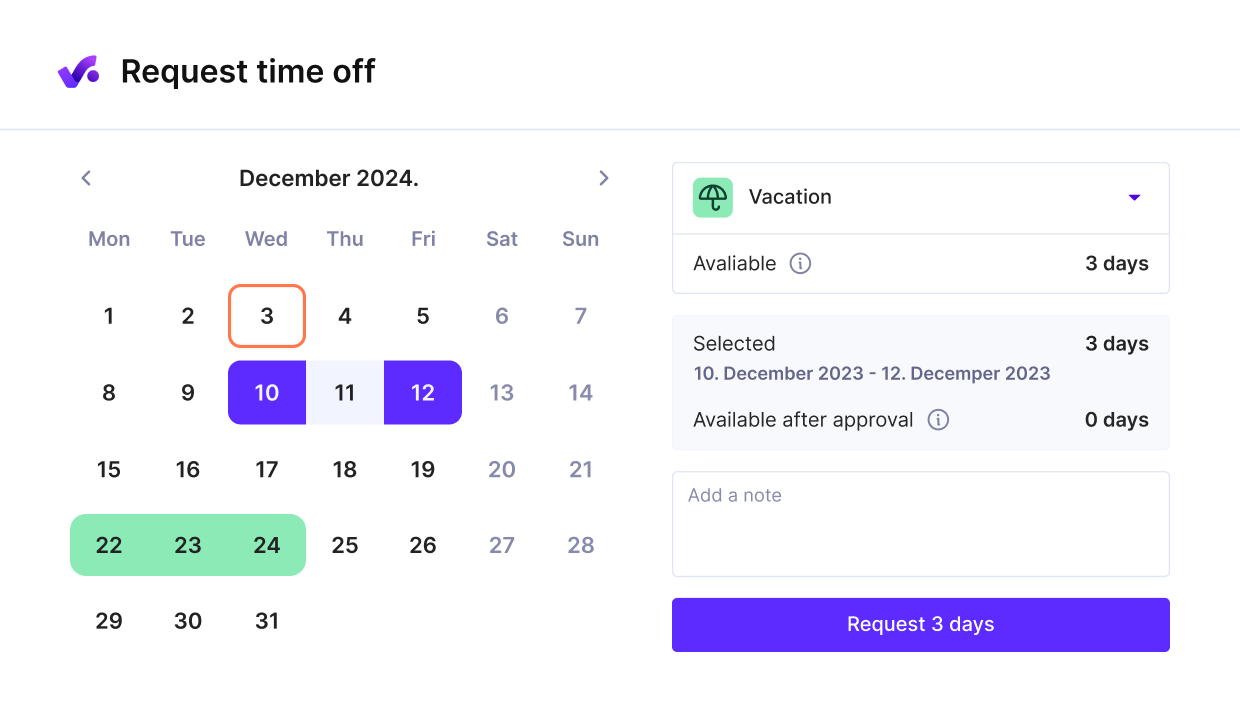
PRODUCTIVE’s STAFF PLANNING TOOLS OFFER FULL OVERSIGHT OF EMPLOYEE AVAILABILITY.
10. Reduce manual work with automations
We’ve talked about standardizing resource planning workflows before, but since working hours are the no. 1 resource, repetitive tasks are a huge resource drain that affect even the most realistic plans.
It’s a fact that manual admin work causes problems for creating bullet proof resource and capacity plans.
Say that a huge deal is won, and the planner has to go back and forth between assessing the required labor and creating tasks with dependencies. The planning process here usually looks something like this:
1. Sales team closes a deal.
2. Manual spreadsheet creation.
3. Project manager manually creates tasks.
4. Resource allocation done via email/meetings.
5. Time tracking requires manual entry.
6. Reporting requires a messy data compilation from multiple sources.
When you use automations, you get streamlined approach based on realistic estimations. Here’s how the planning process would look like with Productive:
1. Deal won in CRM.
2. Automatic project template generated.
3. Tasks auto-created with pre-set estimates.
4. Planners or managers can auto-assign resources (staff) based on skills/availability.
5. Time tracking integrated and semi-automated.
6. Real-time reporting with clicking the timer.
And yes – you can create templates for sales deals, projects, tasks, and budgets. You can also use over 50 templates from our library. You’re welcome.
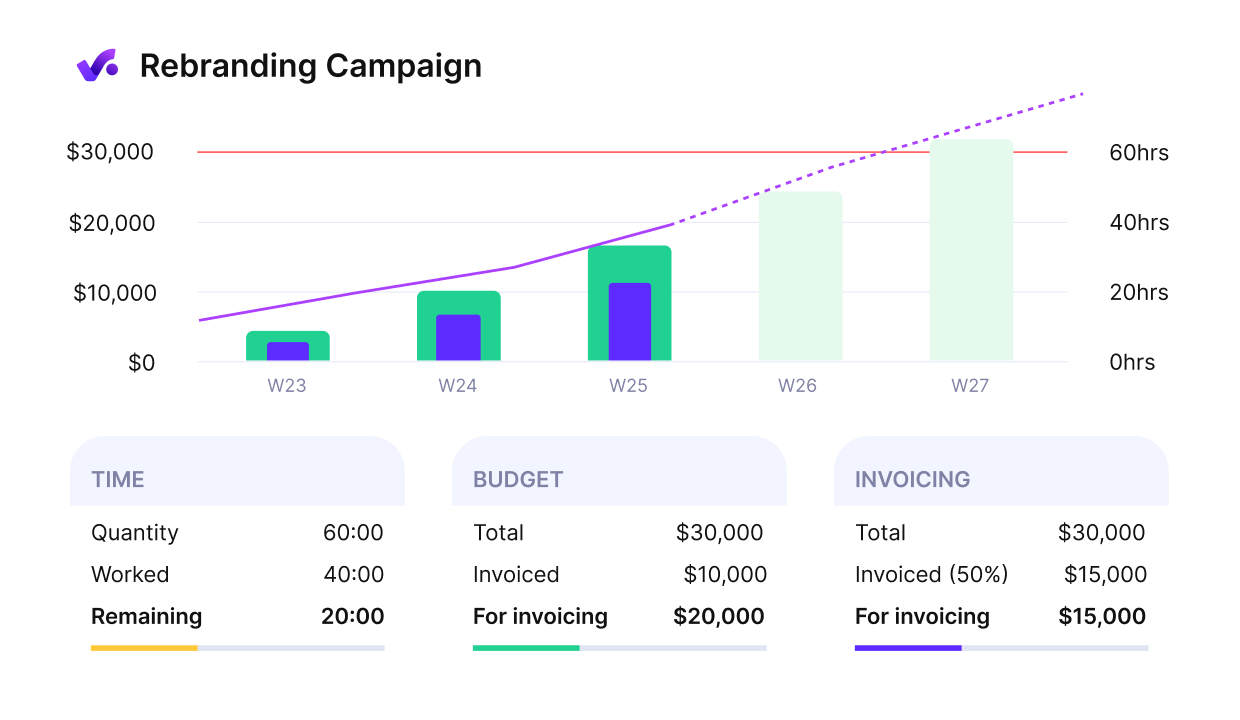
GET FUTURE INSIGHTS INTO YOUR PROJECT’s FINANCES.
What Are the Benefits of Resource Planning for Multiple Projects?
The benefits of resource planning are increased team satisfaction, better project delivery, improved client relationships and optimized performance of daily operations.
The main goal of resource planning is to ensure that a project is progressing smoothly, without unforeseen gaps in resources or uneven employee workloads that can cause stress and burnout. If the resource planning is done right you’ll enjoy the perks we talk about below.
Increased team satisfaction
With good resource planning comes optimized workloads. This means that your employees won’t be stretched thin or underutilized on projects, improving their work-life balance, and increasing engagement and productivity.
Better project delivery
Once you have a satisfied team, you have a project that is progressing well. If you can allocate your resources suitably across tasks and manage change in a timely manner, you increase the chances of meeting project deadlines and delivering quality results.
Improved client relationships
Aside from the benefits that improved project outcomes have, good resource management means higher project transparency and visibility. This also means that you can update your client on project progress at any time, increasing trust and satisfaction.
Optimized company performance
Finally, all of the above has an impact on your strategic operations. If you handle your resources effectively on the basis of accurate data, you can optimize your revenue and profitability. This includes forecasting, which can help you cover resource gaps before taking on new client projects.
Top Challenges of Multi-Project Resource Planning
The challenges of multi-project resource planning are siloed data, data errors due to time-consuming manual processes, inadequate data on resources and unforeseen resource gaps.
Effective resource planning is something that many companies struggle with, especially in the context of project portfolio management.
When it comes to resource planning for single and multiple projects, the main differences lie in the increased complexity and scope. With resource planning for multiple projects, prioritization, effective change management, team collaboration, and visibility all become even more important.
It’s tough having three different teams each having 3-6 projects of varying nature and complexity (…) Some of our projects are very agile, some waterfall, some short, some very, very long. I feel like consistency and predictability has been very hard to get in our world. Some clients have a release every six weeks for years, other clients have one-time, three-month projects. Being able to take all that variability and put it into a consistent process allows us to actually manage it with transparency.
You can learn the most from real-life examples of companies that plan and manage resources for multiple projects. Orion’s company Clear Launch uses Productive to gain more predictability and consistency in their projects.
In case you want to learn more, read our end-to-end project management guide. Lets get back to solving those resource planning challenges.
Bonus Tips for Solving Common Resource Planning Challenges
In the following section, we’ll cover the four most common mistakes in resource planning for multiple projects, and how you can best address them.
We’ll provide you with specific examples of software features that can help you improve your processes and first-hand insights from industry professionals. Keep reading to find the answer to the question: How do you use technology to improve resource planning?
Challenge 1: Working in Silos
The most common cause of silos is using multiple different tools and processes between different project teams. For example, one project manager might introduce a specific project management tool, but the same is not applied company-wide.
This is a more frequent issue for larger agencies with multiple ongoing projects and larger IT budgets.
In smaller companies, the main cause for silos is lack of project visibility between cross-functional teams. In fact, data shows that 39% of employees worldwide believe that people in their organization don’t collaborate enough (Queens University).
For example, on a development project, a developer and a member of the marketing team might have virtually no idea what either one is doing. While it’s difficult and often unnecessary to have different departments working hand in hand 100% of the time, by maintaining a unified strategy, you can significantly improve both project and company outcomes.
The quickest and easiest way of achieving this is to invest in software that can provide project visibility and support to teams of all shapes and sizes. Additionally, choosing an all-in-one agency management software that targets multiple processes at once can help you cut out additional software from the process, which further improves company-wide standardization.
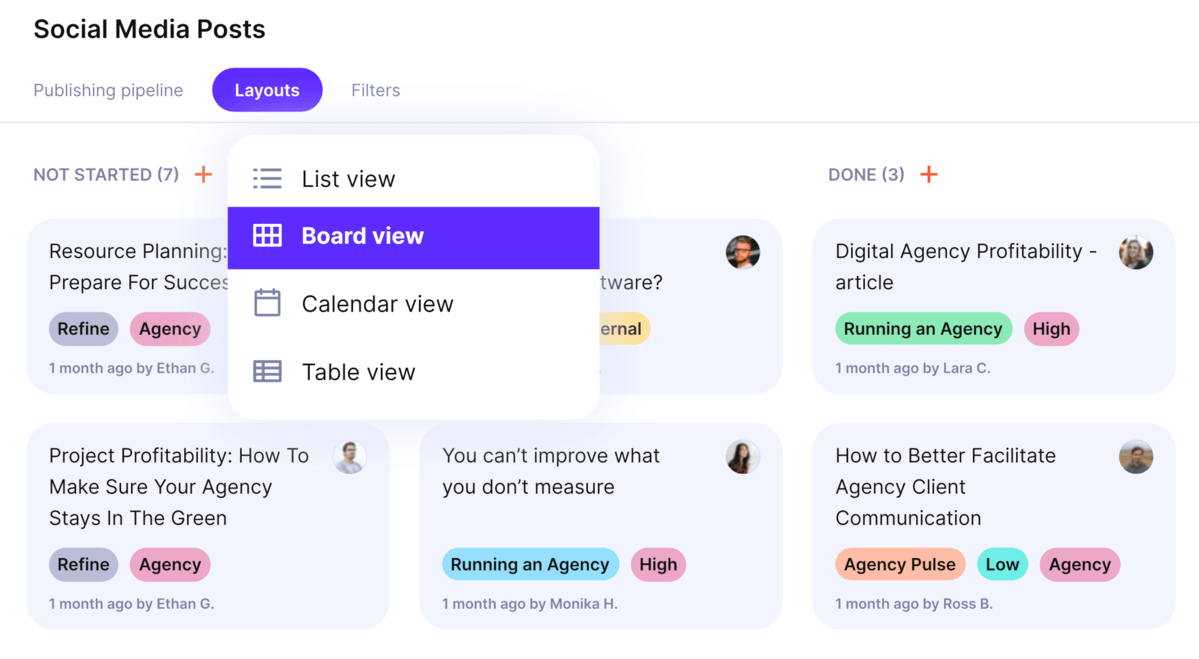
PRODUCTIVE HAS THE FLEXIBILITY TO SUPPORT ALL PROJECT MANAGEMENT STYLES.
Take for example Productive, it combines simplified Project Management with support for sales teams in the integrated Sales Pipeline. You can manage your project progress with task management and automated notifications, all the while tracking your leads down the sales funnel and converting won deals into projects.
The main benefit we get from Productive is planning, clarity, everyone working towards one system. It facilitates reporting, hugely. It’s very easy to use. Also, I think one of the biggest things for me is the fact that it’s constantly improving.
Additionally, Productive can help you set up better client feedback processes. Just like you would share your project boards with your teams, you can invite clients to projects so they can leave comments on tasks.
We talk more about Productive and resourcing in the webinar bellow:
Challenge 2: Using Manual Processes
If a resource manager handles resource plans using an Excel spreadsheet, they will constantly need to go back and manually reschedule tasks. Sooner or later, details will start slipping through the cracks.
By automating this process with a project management solution, you will be resolving two issues at once: data inaccuracy and inefficient processes.
This is the importance of having a real-time overview that is highly reactive to changes. For example, once you allocate your resources with Productive, you can get insights into your project budget burn, all the way up until the deadline.
And if you reschedule some of these resources, you can go back to the burn chart and check what this means for your finances. You can even switch to the project profitability overview to manage and increase profit margins.
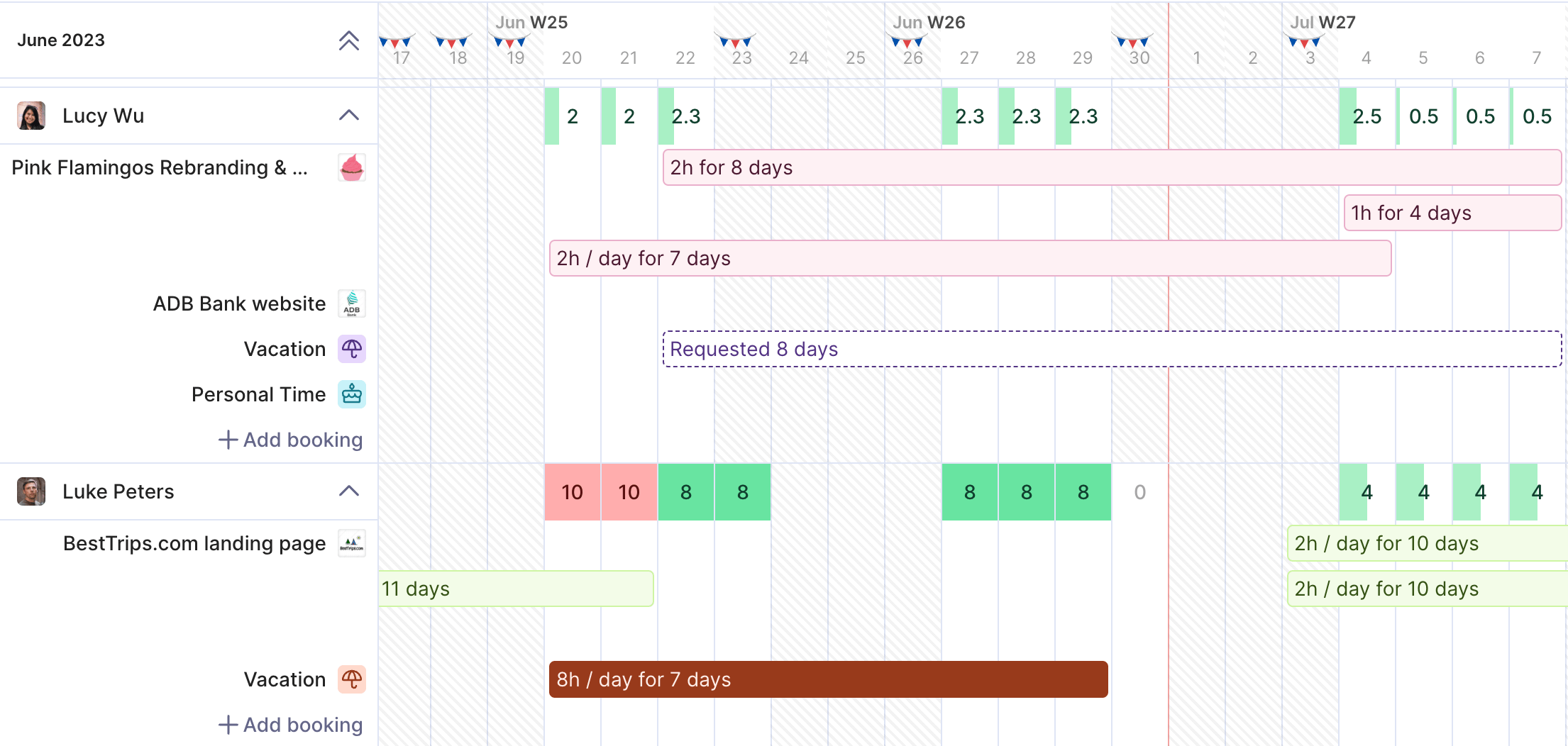
MANAGE YOUR tEAm’S workloads WITH PRODUCTIVE’S EASY-TO-EDIT RESOURCE MANAGEMENT PLAN THAT SUPPORTS MULTIPLE PROJECTS.
This lets you respond to client requests sooner, as well as make informed decisions. Even if you’re over budget, you might still be making a profit on certain projects. This depends mostly on your resource cost rates.
Without using a responsive project capacity planning tool, it’ll be significantly harder to determine the actual costs of projects in time.
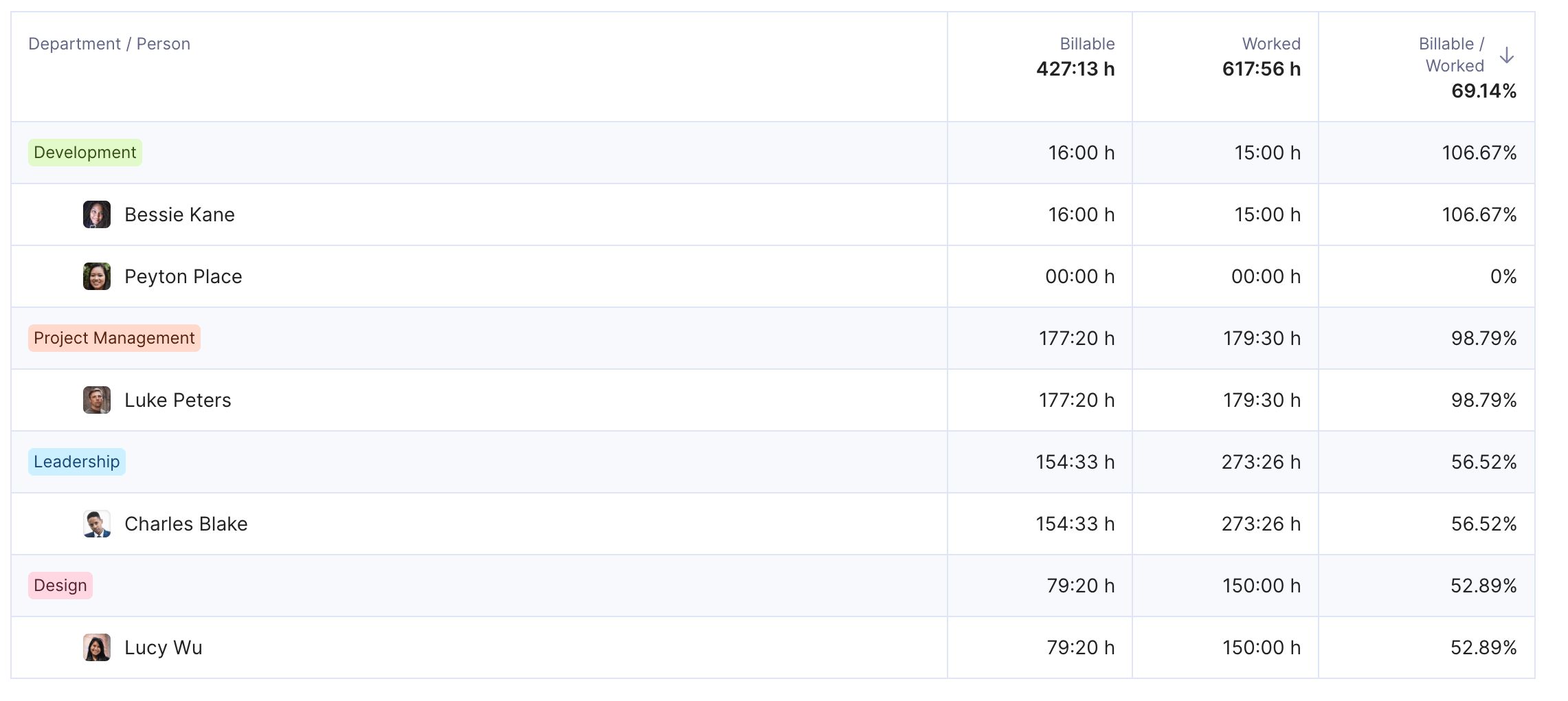
PRODUCTIVE PROVIDES INSIGHTS INTO KEY METRICS IN REAL TIME.
Beyond the resourcing plan, your project reporting will also benefit immensely from using a tool for managing multiple projects. With Productive’s Reporting feature, you can access 50+ agency-focused templates.
Instead of updating them manually, you can benefit from data being pulled directly from the platform. You can even schedule reports to be sent to your or external emails, and keep all project stakeholders in touch with your progress.
We can pull up data really quickly now, tailor it to our needs, and create all kinds of reports in a fraction of time compared to before. This really helped us get a better understanding of our performance in general. We’re also able to detect and address any issues we might have a lot faster than before.
Challenge 3: Inadequate Data on Resources
Continuing on from the previous point, another sign of poor project capacity planning is working blind. A great way to improve your project management is to compare your scheduled time with project actuals.
With Productive’s Budgeting and Time Tracking features, you can get accurate insights into how much time was really spent on billable vs non-billable tasks.
All you have to do is set up your project budget, whether hourly, fixed-price, or mixed. Then, your employees can track their time across these budgets, either by using the timer or by manually inputting time spent on each task.
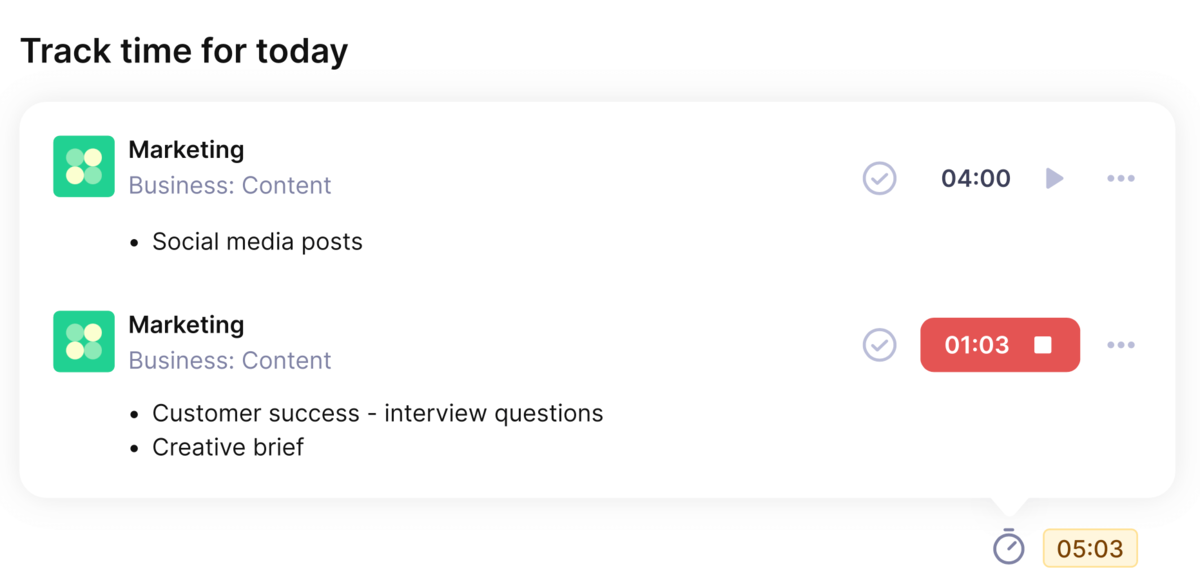
SIMPLIFY HOW YOUR TEAM MANAGES THEIR WORK TIME ENTRIES
By connecting your budgeting and time management, you can also keep a closer eye on your project spending. For example, Productive lets you set up warnings for a percentage of chargeable hours spent on a project. Then, you can check the actual project progress, and see whether you need to reallocate resources or resolve internal conflicts to improve your project workstreams.
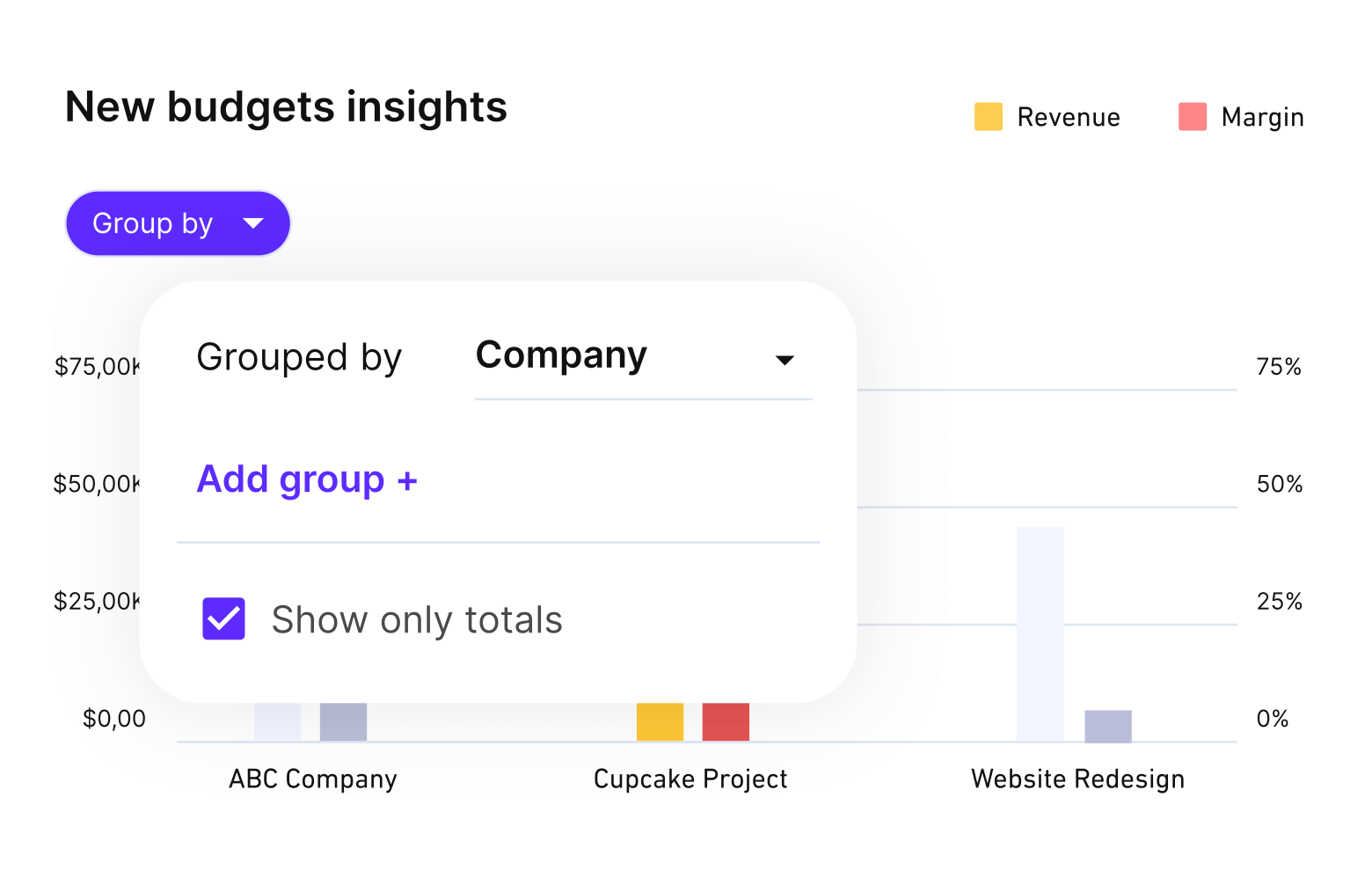
GET FULL CONTROL OVER YOUR PROJECT BUDGETING WITH PRODUCTIVE.
Another important factor to keep in mind is your billable utilization, or the percentage of time spent on billable tasks. This is one of the most important metrics because it shows you how productive your employees really are. Project analysts love Productive because they can track utilization across various metrics, including departments, seniority, skills, and more.
Challenge 4: Unforeseen Gaps in Resources
Unforeseen gaps happen because the person who has the required skill set is either committed to another project or is unavailable to work. These issues have their roots in the lack of organization on the manager level (inadequate workload management), while or mismanagement of human resources.
Hint – learn how to avoid both in our detailed human resource planning guide.
When managers handle requests in Excel or other easily misplaced work documents, situations where project tasks are late due to unavailable resources frequently happen. Consider also state holidays. How many times are resources scheduled without regard for mandatory time off?
Productive provides a simple solution with integrated leave management. Resource managers can input specific types of leave and define which employees are eligible for it. When it comes to holidays, you can easily import them from a calendar for your specific country. This gives you a full overview of your team’s resource availability.

PRODUCTIVE’s STAFF PLANNING TOOLS OFFER FULL OVERSIGHT OF EMPLOYEE AVAILABILITY
Another frequent scenario is caused by agencies taking on too many projects at once. These types of resource constraints are often caused by inadequate planning. One way to resolve this is by using software with forecasting features, such as Productive.
You can create a utilization report for specific date ranges and check how busy certain skills or departments will be during certain periods of time. You can also use placeholders to account for new hires, and then gauge how the potential project would be progressing budget and profit-wise.

GET FUTURE INSIGHTS INTO the profitability of your projects.
This is how Infinum, a digital agency with clients worldwide, uses Productive to support hiring for resource demand:
We have team X, whose Scheduled/Available ratio is 110% when looking into the upcoming quarter. This means that we’ll need an extra 10% of our current capacity to be able to do the work we have scheduled. Then we translate those percentages into the numbers of full time employees we actually need and signal this to HR so that they can start with the hiring process.
Learn how a business can manage hundreds of people with Productive.
All of these features can help you improve your risk management by helping you stay one step ahead of your project.
Final Takeaway: Planning Resources for Multiple Projects
The main thing to keep in mind when resource planning for multiple projects is that the challenges are unique when compared to balancing resources across a single project.
A good resource planning tool can unify your team workflows, provide accurate data (on past and future projects) for timely decision-making, as well as ensure that you can plan resources with regard to their availability. Additionally, certain solutions can provide advanced forecasting capabilities and insights into key metrics, such as billable utilization.
Other than sticking with the shared tips, consider choosing a system that can do all of the above, while providing a user-friendly, scalable solution for professional service companies that work on multiple projects.
Interested? Book a demo with Productive to find out what an all-in-one project management software can do for your company today.
FAQ
What are agency resources?
In an agency context, we can distinguish three key types of resources: these are human resources, time resources, and financial resources. Human resources are the agency’s employees and their characteristics, including skills, seniority, and expertise. Time resources are closely connected to human resources, as they refer to the amount of time you have at your disposal for completing project tasks. Finally, financial resources relate to your project budget, as well as your overall agency capital used to run operations and invest in growth.
What is resource smoothing?
Resource smoothing is a technique that can be used in order to address constraints in the resource pool. It consists of balancing your resources across one or several projects while keeping track of tasks and their dependencies to avoid extending project schedules.
What is resource leveling?
Resource leveling is one of the main risk management methodologies utilized during the project execution phase. It aims to avoid under or over-utilization while shifting the start and end dates of project tasks. Unlike resource scheduling, resource leveling often results in the extension of project deadlines or delayed tasks, but ensures a more balanced distribution of resource demand to minimize burnout.
What is the best resource planning tool for multiple projects?
An example of software for resource planning on multiple projects is Productive. With Productive, you can manage your resource plan in real time, balance workloads with the help of heat maps, take into account employee leave, as well as forecast key metrics such as profitability and budget burn. Some other examples of software with some of the above-mentioned features for managing multiple resources are Resource Guru and LiquidPlanner.
Connect With Agency Peers
Access agency-related Slack channels, exchange business insights, and join in on members-only live sessions.

